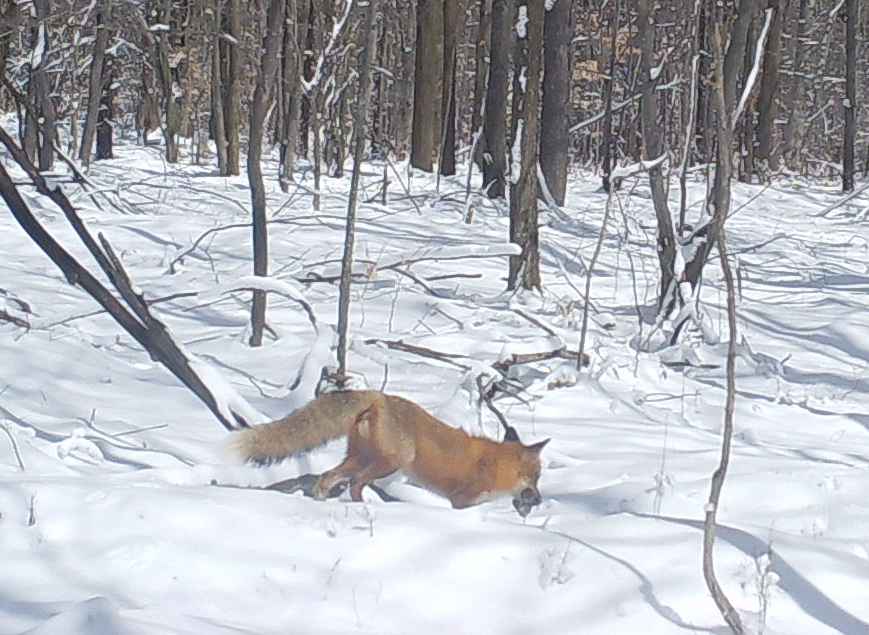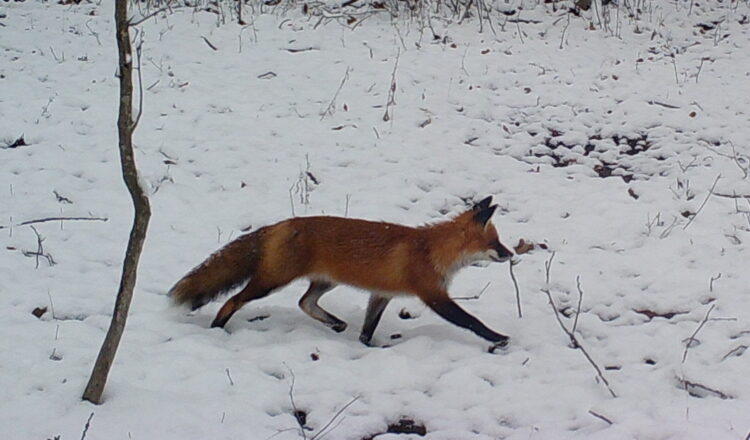“…the two species are quite different”
By Oak Duke
Here in Western New York we have two types of foxes, one is the Red fox, and the other the Gray fox.
And December and January are two of the main months when both species are most visible as their mating season is underway and they scramble around, establishing territories, chasing mates and rivals, and of course participate in their normal hunting and foraging activities.

However, only one of these ubiquitous Fox species is native to the Eastern United States.
It’s the Gray fox.
And while both are considered as Candids, members of the same Family as dogs and wolves, the two species are quite different.
Gray fox evidences a more cat-like behavior.
In fact, the business end of their feet are radically different.
Gray fox claws partially retract as is the case of felines (cats.) This ability to retract their claws inside their paws allows their sharp nails to remain sharp, and not get dulled by walking and running.
And most important, those sharp claws enable Gray fox to scramble up a tree trunk like a squirrel.
The other Fox, the Red fox is an immigrant, introduced from Europe during the 1700s here by hunters. The Red fox is a runner and does not climb trees. It’s claws are more doglike and do not retract.
As in many species of animals and plants, new DNA researchers, allied with social campaigners are currently arguing about origins and literally split hairs, crusading to rename common animals in the name of rigorous taxonomy and societal inclusiveness.
But for our purposes, the two different species of foxes are quite unique and vary much more than just color of their thick, luxurious coats.
Gray fox are very adept at climbing trees, while the Red Fox is not a tree climber at all.
Gray fox will not only climb trees to escape when being chased, but go arboreal in pursuit of food too. They are skillful climbers and can jump at times from tree limb to tree limb.
The European Red fox has a very different genesis.
Historical documents chronicle that colonial fox hunters who wanted to chase foxes with dogs for sport on horseback as they did in the Old Country in the traditional Foxhunting European fashion, were not happy with our indigenous Gray fox.
Accordingly, when the foxhounds started a fox scent, the American Gray fox didn’t flee from the pack of foxhounds by running over the countryside like a proper Red fox would, but instead, quickly took to the trees.
Not much of a horseback chase.

So, as was the case for a number of other introduced species here, from the Ring-necked pheasant, Hungarian partridge, wild boars…hogs plaguing the southern states, to Brown and Rainbow trout, not to mention most of the salmon species in the lakes, sportsmen deserve much of the credit or the blame for their being here.
True to form, Mr. and Mrs. Red Fox escaped the foxhunters and found the new country was to their liking and quickly spread.
As is in the case of many critters, new science, especially with the advent of DNA, is showing us that there are actually many subspecies (45) of foxes and in fact there are indigenous Red foxes in North America, mostly, but rarely found in the Northern Canadian tundra region, along with other subspecies in the Rocky mountains…even in South America, but none in the East here.
In fact, Red fox subspecies are found across Asia and even through Northern Africa, and Australia, making the iconic fox of fable and cartoons known to just about everyone. The various subspecies and cousins differ slightly in coat color, stature, and behavior depending upon the region.
But foxes have to eat and according to some researchers have wrecked havoc in many ecosystems upon indigenous birds, rodent populations, even turtles. However, foxes of both species are omnivores. Besides eating small birds and rodents, foxes dine on seeds, nuts, insects, carrion, snakes, apples and nuts.
In some regions, such as Australia and New Zealand, Red foxes have been designated as one of its worst invasive species because of their impact on indigenous species that become prey and food for the fox.
Both species of foxes, Red and Gray predate heavily on rodent populations wherever they are, and many of us have been entertained by watching foxes jump high, then land with all four feet in their seemingly perpetual hunt for field mice.
Gray fox have also been transported by man to other climes.
Grays have been reported, after being introduced by man, to have established populations on islands throughout the world as humans have released them for their skill as mousers, hoping to control invasive European rat and rodent populations (which were also introduced by man to all corners of the world.)
But unfortunately…even catastrophically, other indigenous critters inhabiting these islands, from birds to reptiles, appear to have offered an unforeseen, if not easier meal for the growing fox families.
Oak Duke/Wellsville, NY/ December 2023

Facebook pages:
Whitetail Page: www.facebook.com/Oak.Duke.whitetail.page
Duke’s Honey: www.facebook.com/Dukes-Honey-513590015445371/







